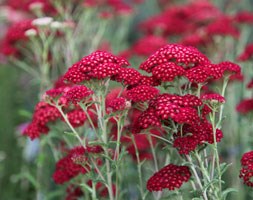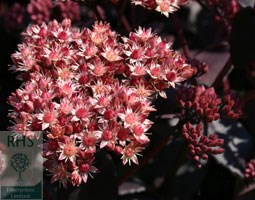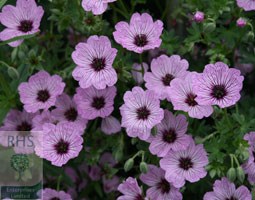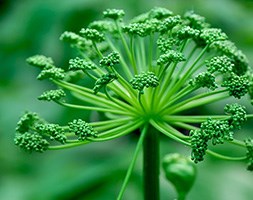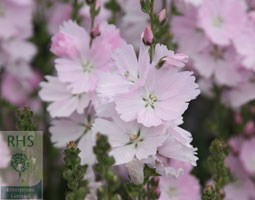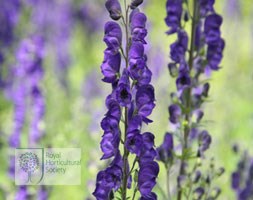New products at Crocus
by Sarah - May 27th, 2015.Filed under: Crocus, New Products.
Crocus has these new items today
Achillea millefolium ‘Red Velvet’ (common yarrow) £5.99
Position: full sun Soil: moist, well-drained, non acidic Rate of Growth: fast-growing Flowering period: May to August Hardiness: fully hardy The flattened, rosy-red flowerheads are held on upright stems above the aromatic fern-like foliage throughout summer. This cultivar is said to have a good resistance to colour fade. Best in full sun in the middle rank of the border. Achilleas will attract many beneficial insects including bees, butterflies and hoverflies to the garden. Garden care: Protect from slugs. Stake using twiggy stems before the flowers appear. Cut back after first flowering to encourage secondary flush in late summer/early autumn. Old clumps can be revived by liftin g, splitting and replanting in spring.
Sedum telephium (Atropurpureum Group) ‘Purple Emperor’ (orpine) £5.99
Position: full sun or partial shade Soil: moderately fertile, well-drained, neutral to slightly alkaline soil Rate of growth: average to fast-growing Flowering period: August to October Flower colour: red-purple Other features: attractive to butterflies and bees; the dried flower-heads provide colour and structure in the winter garden Hardiness: fully hardy Dramatic, deep bronze-purple succulent leaves topped with red-purple flower-heads from August to October. In certain light conditions the foliage of this sedum appears almost black. Perfect for use at the front of a sunny, well-drained border or in a large patio pot, the flower-heads are a valuable source of nectar for butterflies and bees. Garden care: The flowerheads look great left during the winter to add shape and texture to your border. In February and March cut back the old flowerheads and apply a generous 5-7cm (2-3in) mulch of well-rotted garden compost or manure around the base of the plant. Once established, sedums can have a tendency to flop leaving an open and unsightly centre, especially in fertile soil. One technique to help prevent this is the ‘Chelsea chop’. During the last week of May (Chelsea Flower Show week), cut one in every three stems back to the ground. This will produce plants that are less lush and flower slightly later.
Astilbe ‘Fanal’ (x arendsii) (false goatsbeard) £4.99
Position: full sun or partial shade Soil: moist, humus-rich soil Rate of Growth:vigorous Flowering period: May to June Hardiness: fully hardy Deep red, fluffy plumes appear above serrated, dark green leaves in early summer. The flowers of this astilbe are self-supporting and retain their colour for a few weeks. Ideal for a bog garden or moist border, it thrives in clay soil as long as it is not allowed to dry out during the summer months. Although it can grow in drier soils, it does need to be in a shady spot. Garden care: Newly planted astilbes need to be kept well watered until they are established. Lift and divide large clumps every three or four years in late winter or early spring, discarding old woody rhizomes. Mulch with well-rotted organic matter in spring.
Geranium (Cinereum Group) ‘Ballerina’ (cranesbill) £4.99
Position: full sun or partial shade Soil: fertile, well-drained soil Rate of growth: fast growing Flowering period: May to July Hardiness: fully hardy This early-flowering, dwarf geranium has small, deep pink flowers with maroon ve ins and centres and pretty, deeply cut, grey-green leaves. It looks particularl y good planted en masse in a rock garden, or at the edge of a raised border, whe re its rather shy flowers can be appreciated. Provided it has good drainage, it will produce a mass of attractively veined pink flowers from late spring to ear ly summer. Garden care: In midsummer rejuvenate plants that are beginning to look jaded, by removing old flowered stems and leaves. Lift and divide large colonies in spring.
Angelica archangelica (angelica) £4.99
Position: full or partial shade Soil: deep, moist, fertile, loamy soil Rate of growth: average Flowering period: June and July Hardiness: fully hardy (but short-lived) A majestic and impressive perennial with handsome foliage, and in early summer, rounded umbels up to 25cm across, of small green flowers. Ideally suited to a reliably moist soil in partial to full shade, it has a striking achitectural presence and looks wonderful at the back of the border. Often short-lived, it will usually die back after flowering, but will self-seed freely if the conditions are favourable. Garden care: This plant usually dies after flowering, but if flowering is prevented, or the spent flowers are removed before they set seed, then it will often flower again for a second year.
Sidalcea ‘Elsie Heugh’ (prairie mallow) £4.99
Position: full sun Soil: light, moderately fertile, humus-rich, moist but well- drained, neutral to slightly acid soil Rate of growth: average Flowering period: June to July Flower colour: purple-pink Hardiness: fully hardy An open, upright perennial which produces spires of large, satin-like, purple-pink flowers that have fringed petals. These rise above the rounded, mid green foliage in early to mid summer and look great when planted with soft blues and purples in a mixed or herbaceous bed. Garden care: Cut the stems back hard to ground level after flowering to encourage a second flush. Apply a deep, dry mulch of straw or bracken around the crown of the plant in autumn. Lift and divide congested colonies in spring
Aconitum napellus (monkshood) £4.99
Position: sun to partial shade Soil: moist, fertile Rate of Growth: average Flowering period: July to August Hardiness: fully hardy This stately monkshood produces erect spikes of hooded, violet-blue flowers in mid and late summer above deeply divided, dark green leaves. Although it will take some sun, it is perfect for the back of a shady border, where it needs little attention. The stems seldom need staking and, since all parts of the plant are highly poisonous, pests tend to leave them well alone. Garden care: Prepare an extra deep planting hole at least 45cm (18in) deep, adding well-rotted organic matter to prevent the soil from drying out in summer. Always wear gloves when working with monkshood since all parts of the plant are poisonous and a potential skin irritant. Cut the flowering stem to within 15cm of the ground in the autumn to prevent it self seeding.







